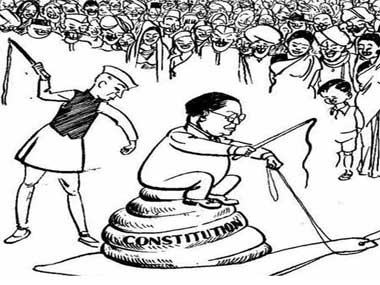by Abhay Vaidya The latest round of antics around the personality of Dr Babasaheb Ambedkar leaves little doubt that India needs to rescue her great son from the clutches of the self-serving Dalit leadership. By raking up non-issues at the cost of genuine welfare of the poor, the Dalit leaders of the day have heaped greater insult and injury on Ambedkar than any single cartoon in a school textbook. How come, for example, that the Ramvilas Paswans, Ramdas Athavales, Balasaheb Ambedkars and other Dalit leaders are not heard vociferously condemning the Rs 86 crore public money spent by Mayawati to renovate her bungalow? What great welfare of the Dalits did Mayawati achieve by doing this or by erecting her own statues and sprawling memorials to Ambedkar? It is only after she was rejected by the voters of UP that there is talk of constructing hospitals for the poor in the vacant space of the memorials. On Friday, the Dalit MPs and others created commotion and disrupted the Lok Sabha after a member protested that Ambedkar had been insulted through a cartoon in a political science textbook for class XI. Well-known political scientists Yogendra Yadav and Suhas Palshikar who had approved the cartoon, resigned hours later and pointed out that the cartoon by Shankar was never seen as disrespectful by Ambedkar himself or the dalits when it first appeared in 1949. To suggest that class XI students would be influenced by that cartoon and start thinking lesser of Ambedkar is to underestimate the students and question one’s own intelligence. [caption id=“attachment_307313” align=“alignleft” width=“380” caption=“By raking up non-issues at the cost of genuine welfare of the poor, the Dalit leaders of the day have heaped greater insult and injury on Ambedkar than any single cartoon in a school textbook.”]  [/caption] Such is the mindless fury with which Dalit leaders make an issue out of a perceived insult to Ambedkar that the government of the day capitulates and bends backwards to meet their unreasonable demands. Thus, on Friday, HRD minister Kapil Sibal promptly apologised and also announced the withdrawal of the textbook. The previous high point for the Dalit leadership was in Maharashtra over the demand for the Indu Mills land for an international memorial to Ambedkar, close to the spot in Dadar where he was cremated. Such victories over cartoons and memorials have been giving the Dalit leaders a sense of high achievement. It does not matter to them that rather than creating a united front as desired by Ambedkar, they are in fact insulting him by remaining fragmented to prop up their individual factions. The Dalit leaders have been focusing single-mindedly on acquiring political power while neglecting the cause of Dalit uplift through education and enterprise, as was desired by Ambedkar. A more constructive effort has been undertaken by businessman Milind Kamble who established the Dalit Indian Chamber of Commerce (DICCI) with the slogan, “Be Job Givers instead of Job Seekers”. Kamble tries to inspire the Dalit youth by pointing out that while Ambedkar benefitted from scholarships, he was never the product of a reservations policy. The Dalit masses expect little from their leaders and therefore, at the time of elections in Maharashtra, all the factions of the Republican Party of India — including the one led by Ambedkar’s grandson — return with empty coffers. The Dalit masses vote for all other parties but the RPI. The leaders have therefore been clutching on to Ambedkar’s image and raising a hue and cry over imagined slurs and insults simply to draw legitimacy. This nonsense will come to an end only when the rest of India rescues Ambedkar from the shackles of his ‘Dalit’ branding: Ambedkar is first and foremost a great son of India and a Dalit icon. Perhaps it’s time to rework our understanding of Ambedkar so that at least the future generations don’t make the mistake of reducing him to an icon of the Dalits alone.
Ambedkar must be freed from his ‘Dalit’ branding and treated as an Indian icon first.
Advertisement
End of Article
Written by FP Archives
see more


)

)
)
)
)
)
)
)
)



